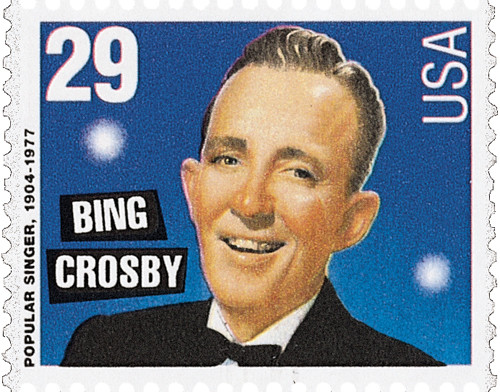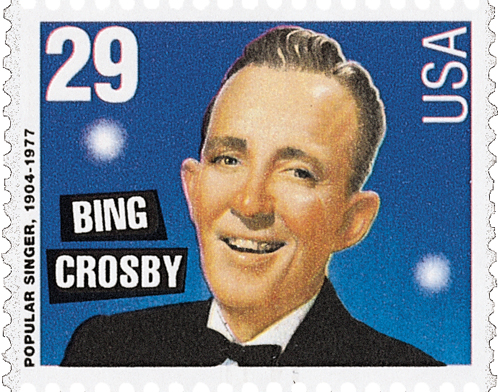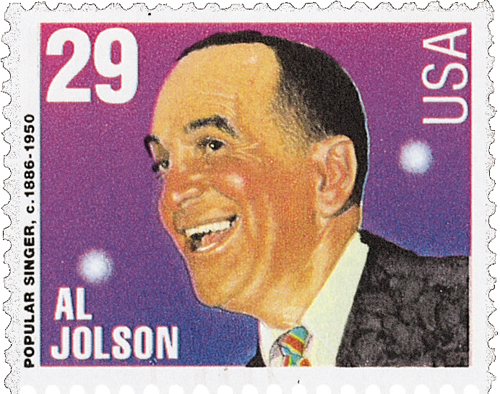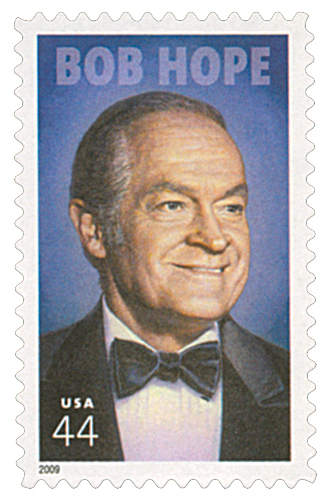
# 2850 FDC - 1994 29c Popular Singers: Bing Crosby
US #2850
1994 Bing Crosby
- From the Popular Singers set
- Part of the Legends of American Music series
- Features five famous singers from the 20th century
Category of Stamp: Commemorative
Set: Legends of American Music series
Value: 29¢
First Day of Issue: September 1, 1994
First Day City: New York, New York
Quantity Issued: 35,436,000
Printed by: Stamp Venturers
Printing Method: Photogravure
Format: Panes of 20, from printing cylinders of 180 subjects (12 across, 15 down)
Perforations: 10.2 X 10.2
Reason the stamp was issued: The Popular Singers stamps were issued as part of the Legends of American Music series. They honor some of the most famous popular singers of the 20th century, including Al Jolson
About the stamp design: Artist and magazine illustrator C.F. Payne was chosen to create the artwork for the Popular Singers stamps. Using photos provided by the USPS, he produced color sketches, then painted the singers using acrylic, watercolor, ink, oil paint, colored pencils, and airbrush.
Special design details: The background colors were chosen to fade into one another to give a sense of continuity to the set.
First Day City: The First Day of Issue ceremony took place at Damrosch Park in New York City. Family members and friends of those honored on the stamps were present at the ceremony. The ceremony also launched the US Postal Service’s month-long American Music Stamp Festival.
About the Legends of American Music Series: The Legends of American Music Series debuted on January 8, 1993, and ran until September 21, 1999. The stamps were issued in semi-jumbo size. The name of each performer is in white letters, sometimes on a black background to make it stand out. The name of the set is shown running up the left side of the stamp.
More than 90 artists are represented from all styles of music: rock ‘n’ roll, rhythm and blues, country and western, jazz and pop, opera and classical, gospel and folk. In addition to individual singers and Broadway musicals, subjects include band leaders, classical composers, Hollywood songwriters and composers, conductors, lyricists, and more. The Legends of American Music Series was a huge advancement for diversity because it honored many Black and female artists.
History the stamp represents:

The best-selling record artist of the 20th century, Bing Crosby, was born Harry Lillis Crosby, Jr., in Tacoma, Washington, on May 3, 1903. The fourth of seven children, Crosby spent his first three years in Tacoma before the family moved to Spokane. When he was seven years old, Crosby received his new name. At the time, he and a neighbor enjoyed a Sunday feature of the Spokesman-Review called the Bingville Bugle. His neighbor began calling him Bingo from Bingville, and later just Bing.
When he was 14, Crosby began working at the Spokane Auditorium, where he had the opportunity to see some of the day's biggest performers. Among them, Al Jolson left the largest impression, captivating Crosby with his ad-libbing and spoofs of Hawaiian songs. He later described Jolson's performances as "electric." Crosby went on to attend Gonzaga University for three years, but didn't graduate (though he was later awarded an honorary doctorate).

In 1923, Crosby began his performing career with the Musicaladers, a music group that lasted for two years. He then went back to working in the auditorium, where he occasionally sang in a trio between films. Then, in 1925, he and friend Al Rinker decided to go to Los Angeles to become stars. They got their first jobs at The Syncopation Idea before being discovered by Paul Whiteman.
Naming them the Rhythm Boys, Whiteman gave their careers a major boost with their first recording and booking them shows in Chicago and New York. Additionally, Crosby was soon in high demand as a solo artist on record and radio. In 1928, he had his first number one hit with "Ol' Man River." Despite the success, Crosby soon became dissatisfied with Whiteman, and he and the Rhythm Boys left and joined the Gus Arnheim Orchestra. Soon Crosby's solos began stealing the shows, and he was offered a solo radio broadcast in New York. Crosby made his solo radio debut in September 1931 and was then hired for a weekly 15-minute broadcast that yielded some of the year's best-selling songs.
Soon, Crosby was the leading singer in America, with 10 of the top 50 songs of 1931. In 1932, he starred in his first full-length movie, The Big Broadcast. Following the success of that film, Crosby received a contract with Paramount, filming three movies a year. While he cut down on his live performances, Crosby produced a number of successful records at a time when record sales were low because of the Depression.

After replacing Paul Whiteman as host of Kraft Music Hall, Crosby worked on the film Pennies From Heaven. He fought to get his idol Louis Armstrong in the movie and also to give him equal billing with his white co-stars, which had rarely been done at that time. Armstrong's career boomed after the film, and he was always thankful to Crosby.
Over the next few years Crosby helped usher in the era of the crooner. On Christmas Day, 1941, he debuted his most popular song, "White Christmas." It was featured in Holiday Inn the following year and was re-released for the holidays several times in the coming years.
During World War II, Crosby performed for American troops fighting in Europe. At the end of the war, US troops considered Crosby the person who'd done the most for their morale, ahead of President Franklin Roosevelt, General Dwight Eisenhower, and Bob Hope.

Beginning in 1940, Crosby starred with Bob Hope and Dorothy Lamour in seven Road to... musical comedies. In 1949, he voiced the narration for Disney's The Legend of Sleepy Hollow segment of the animated film, The Adventures of Ichabod and Mr. Toad. Crosby made his way to television in the 1950s, beginning with The Fireside Theater.
Crosby's health began to suffer in the 1970s, though he continued to perform. He suffered a heart attack at a Spanish golf course on October 14, 1977.
Called "the greatest entertainer of the 20th century," Crosby made more non-rock recordings and placed more songs in the "Top Ten" than any other individual singer. His career as an entertainer spanned more than 50 years, during which time he recorded over 1,600 songs and sold more than 500 million records.
US #2850
1994 Bing Crosby
- From the Popular Singers set
- Part of the Legends of American Music series
- Features five famous singers from the 20th century
Category of Stamp: Commemorative
Set: Legends of American Music series
Value: 29¢
First Day of Issue: September 1, 1994
First Day City: New York, New York
Quantity Issued: 35,436,000
Printed by: Stamp Venturers
Printing Method: Photogravure
Format: Panes of 20, from printing cylinders of 180 subjects (12 across, 15 down)
Perforations: 10.2 X 10.2
Reason the stamp was issued: The Popular Singers stamps were issued as part of the Legends of American Music series. They honor some of the most famous popular singers of the 20th century, including Al Jolson
About the stamp design: Artist and magazine illustrator C.F. Payne was chosen to create the artwork for the Popular Singers stamps. Using photos provided by the USPS, he produced color sketches, then painted the singers using acrylic, watercolor, ink, oil paint, colored pencils, and airbrush.
Special design details: The background colors were chosen to fade into one another to give a sense of continuity to the set.
First Day City: The First Day of Issue ceremony took place at Damrosch Park in New York City. Family members and friends of those honored on the stamps were present at the ceremony. The ceremony also launched the US Postal Service’s month-long American Music Stamp Festival.
About the Legends of American Music Series: The Legends of American Music Series debuted on January 8, 1993, and ran until September 21, 1999. The stamps were issued in semi-jumbo size. The name of each performer is in white letters, sometimes on a black background to make it stand out. The name of the set is shown running up the left side of the stamp.
More than 90 artists are represented from all styles of music: rock ‘n’ roll, rhythm and blues, country and western, jazz and pop, opera and classical, gospel and folk. In addition to individual singers and Broadway musicals, subjects include band leaders, classical composers, Hollywood songwriters and composers, conductors, lyricists, and more. The Legends of American Music Series was a huge advancement for diversity because it honored many Black and female artists.
History the stamp represents:

The best-selling record artist of the 20th century, Bing Crosby, was born Harry Lillis Crosby, Jr., in Tacoma, Washington, on May 3, 1903. The fourth of seven children, Crosby spent his first three years in Tacoma before the family moved to Spokane. When he was seven years old, Crosby received his new name. At the time, he and a neighbor enjoyed a Sunday feature of the Spokesman-Review called the Bingville Bugle. His neighbor began calling him Bingo from Bingville, and later just Bing.
When he was 14, Crosby began working at the Spokane Auditorium, where he had the opportunity to see some of the day's biggest performers. Among them, Al Jolson left the largest impression, captivating Crosby with his ad-libbing and spoofs of Hawaiian songs. He later described Jolson's performances as "electric." Crosby went on to attend Gonzaga University for three years, but didn't graduate (though he was later awarded an honorary doctorate).

In 1923, Crosby began his performing career with the Musicaladers, a music group that lasted for two years. He then went back to working in the auditorium, where he occasionally sang in a trio between films. Then, in 1925, he and friend Al Rinker decided to go to Los Angeles to become stars. They got their first jobs at The Syncopation Idea before being discovered by Paul Whiteman.
Naming them the Rhythm Boys, Whiteman gave their careers a major boost with their first recording and booking them shows in Chicago and New York. Additionally, Crosby was soon in high demand as a solo artist on record and radio. In 1928, he had his first number one hit with "Ol' Man River." Despite the success, Crosby soon became dissatisfied with Whiteman, and he and the Rhythm Boys left and joined the Gus Arnheim Orchestra. Soon Crosby's solos began stealing the shows, and he was offered a solo radio broadcast in New York. Crosby made his solo radio debut in September 1931 and was then hired for a weekly 15-minute broadcast that yielded some of the year's best-selling songs.
Soon, Crosby was the leading singer in America, with 10 of the top 50 songs of 1931. In 1932, he starred in his first full-length movie, The Big Broadcast. Following the success of that film, Crosby received a contract with Paramount, filming three movies a year. While he cut down on his live performances, Crosby produced a number of successful records at a time when record sales were low because of the Depression.

After replacing Paul Whiteman as host of Kraft Music Hall, Crosby worked on the film Pennies From Heaven. He fought to get his idol Louis Armstrong in the movie and also to give him equal billing with his white co-stars, which had rarely been done at that time. Armstrong's career boomed after the film, and he was always thankful to Crosby.
Over the next few years Crosby helped usher in the era of the crooner. On Christmas Day, 1941, he debuted his most popular song, "White Christmas." It was featured in Holiday Inn the following year and was re-released for the holidays several times in the coming years.
During World War II, Crosby performed for American troops fighting in Europe. At the end of the war, US troops considered Crosby the person who'd done the most for their morale, ahead of President Franklin Roosevelt, General Dwight Eisenhower, and Bob Hope.

Beginning in 1940, Crosby starred with Bob Hope and Dorothy Lamour in seven Road to... musical comedies. In 1949, he voiced the narration for Disney's The Legend of Sleepy Hollow segment of the animated film, The Adventures of Ichabod and Mr. Toad. Crosby made his way to television in the 1950s, beginning with The Fireside Theater.
Crosby's health began to suffer in the 1970s, though he continued to perform. He suffered a heart attack at a Spanish golf course on October 14, 1977.
Called "the greatest entertainer of the 20th century," Crosby made more non-rock recordings and placed more songs in the "Top Ten" than any other individual singer. His career as an entertainer spanned more than 50 years, during which time he recorded over 1,600 songs and sold more than 500 million records.













